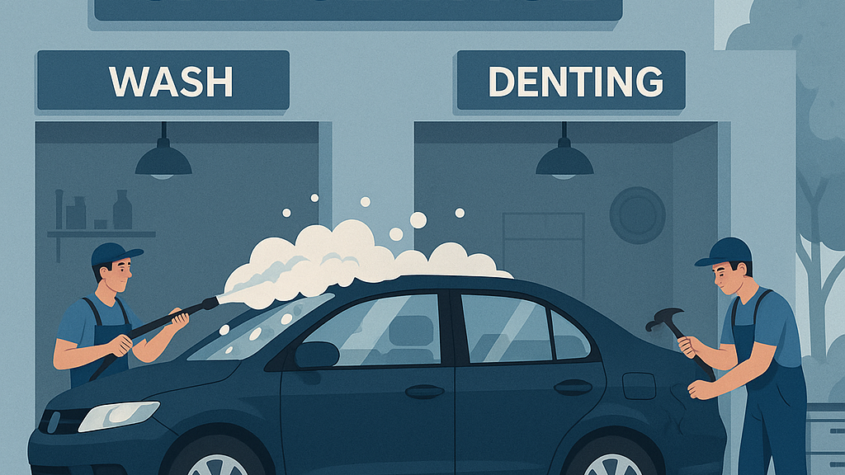
Ceramic coating for cars has become an increasingly popular choice among vehicle owners looking to protect their investment. This advanced technology forms a durable layer over the vehicle’s paint, offering superior protection against UV rays, scratches, and chemical contaminants. With the right application, it can enhance the car’s appearance and make maintenance much easier.
Ceramic Coating Car solutions are popular among both car enthusiasts and everyday drivers for their ability to provide long-lasting shine and hydrophobic properties. This means dirt and water slide off more easily, keeping the car cleaner for longer periods. The benefits of applying a ceramic coating extend beyond aesthetics; it can also help to preserve the vehicle’s resale value.
As more people seek effective ways to maintain their cars, understanding how ceramic coatings work and what they offer is essential. From application techniques to maintenance tips, exploring this topic can empower any car owner to make an informed decision about protecting their vehicle.
Benefits of Ceramic Coating
Ceramic coatings offer several advantages for vehicle protection. These include enhanced paint protection, ease of cleaning, resistance to UV rays, and hydrophobic properties. Each benefit plays a vital role in maintaining the vehicle’s appearance and longevity.
Enhanced Paint Protection
Ceramic coatings create a strong, protective layer over the vehicle’s paint. This barrier shields the paint from scratches, contaminants, and chemical stains. The hardness of ceramic coatings can resist minor abrasions, which helps maintain the showroom quality of the paint.
Additionally, they are resistant to harsh environmental elements. Factors like bird droppings, tree sap, and road salt can damage unprotected surfaces. With ceramic coatings, vehicles maintain their aesthetic appeal even in challenging conditions.
Ease of Cleaning
A significant benefit of ceramic coatings is the ease of cleaning. The smooth surface created by the coating prevents dirt and grime from adhering effectively. This results in less time spent on washing and more efficient cleaning processes.
Using a microfiber cloth or a simple rinse is often sufficient to remove surface contaminants. Wax and polish become less necessary, reducing the frequency of maintenance. This simplicity enhances the vehicle owner’s experience and saves time.
UV Ray Resistance
UV rays can cause deterioration and fading of a vehicle’s paint over time. Ceramic coatings are formulated to provide a level of UV protection that helps prevent such damage. This resistance helps maintain the vibrancy of the paint.
By preserving the vehicle’s exterior, owners can enjoy its aesthetic for longer. It also helps in retaining the vehicle’s resale value. Protecting against UV radiation is crucial in areas with intense sunlight exposure.
Hydrophobic Properties
Ceramic coatings feature hydrophobic properties, meaning they repel water effectively. This causes water to bead and slide off surfaces, reducing water spots and the accumulation of dirt. As a result, vehicles treated with ceramic coatings stay cleaner for longer periods.
The hydrophobic quality also aids in drying the vehicle after rain or washing. Reduced drying time means less risk of watermarks. This feature ensures that maintaining a polished look becomes less labor-intensive.
Application Process
The application of ceramic coating involves meticulous steps to ensure optimal bonding and protection. It requires thorough surface preparation, careful layering, and adequate curing time to achieve the best results.
Surface Preparation
Proper surface preparation is critical for the effectiveness of ceramic coating. This process typically begins with washing the vehicle to remove dirt, grime, and contaminants. A pH-neutral car wash soap is recommended.
After washing, the next step involves decontaminating the surface with a clay bar. This step removes embedded contaminants, ensuring a smooth base. For further cleaning, using an isopropyl alcohol solution helps eliminate oils and residues.
Lastly, a thorough inspection for imperfections is essential. Any scratches or swirl marks should be polished out, as these flaws can affect the coating’s appearance and performance.
Layering
Layering the ceramic coating must be executed with precision. The application usually begins from the top of the vehicle and progresses downward. This strategy prevents dust and debris from settling on freshly coated areas.
A multi-layered approach is often recommended to enhance protection. Each layer should be applied evenly and allowed to flash, or partially cure, before adding the next. Typically, two to three layers are ideal for maximum durability.
Tools such as foam applicators or microfiber towels are useful for an even application. Using a cross-hatch motion helps to ensure complete coverage and minimizes streaks.
Curing Time
Curing time is crucial for allowing the ceramic coating to achieve maximum hardness and bonding. After application, the vehicle should be kept in a controlled environment, away from moisture and direct sunlight.
Most ceramic coatings require an initial curing period of 24 hours before exposing the surface to water or contaminants. Full curing can take up to a week or longer, depending on environmental conditions.
During this period, it is advisable to avoid washing the vehicle and to keep it parked in a stable environment. This ensures that the coating bonds properly, providing long-lasting protection.
Recycling Drop Off Locations: Find Convenient Sites for Sustainable Waste Disposal
Finding convenient recycling dropoff locations can greatly simplify the process of sustain…









